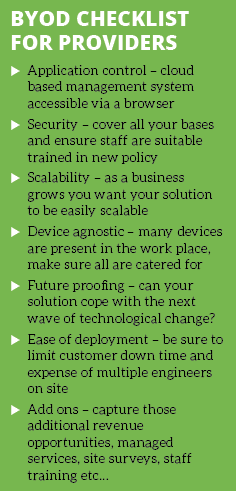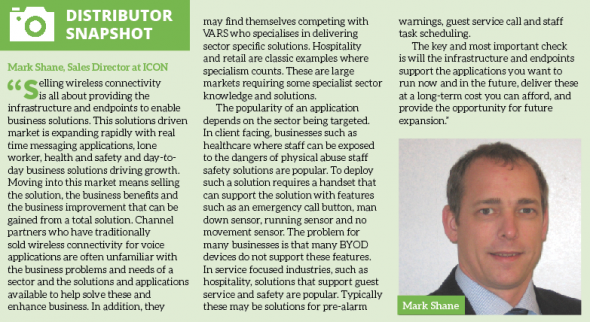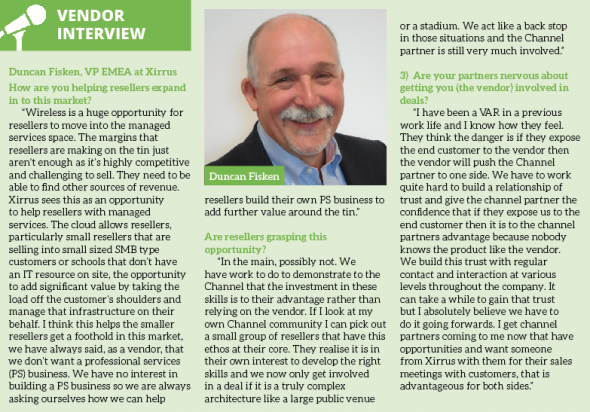
The Internet of Things, cloud and BYOD are changing the business user’s expectations of network IT. In the past, network managers had days and weeks to provision the network to accommodate new users, devices and applications. Today, users are bringing new devices to the workplace every day and expect instant connectivity. Demand for wireless solutions has been growing exponentially over the last five years and now with the second wave of 802.11ac standards coming in 2015 we will see vast improvements in data speeds and capacity issues on large scale networks. This combination of demand and technology improvements will present much opportunity to those resellers that manage to position themselves accordingly. David Dungay investgates.
 According to Ofcom 93% of adults in the UK own a mobile phones, of which 61% are smart phone, the demand for high quality Wi-Fi connections is a must for all businesses. The increase in BYOD has seen employees and customers using their own devices, expecting full access for business and personal applications.
According to Ofcom 93% of adults in the UK own a mobile phones, of which 61% are smart phone, the demand for high quality Wi-Fi connections is a must for all businesses. The increase in BYOD has seen employees and customers using their own devices, expecting full access for business and personal applications.
Keith Newton is Business Development Manager for SilverNet, he says “For resellers, this offers an immediate opportunity due to the high demand for wireless products. This is not just about creating hotspots which sell well now, but also the opportunity to scale out these products to supply a complete wireless transmission solution for towns and businesses. By offering additional services such as surveys, installation and service contracts, resellers can increase their revenue. A good manufacturer of quality products is essential along with distributors who offer fair margins to their resellers.”
Gavin Wheeldon, CEO of Purple WiFi agrees, “Customers are beginning to expect more from their wireless than simply providing a WiFi hotspot. Many resellers are seeing this as a potential sales opportunity, selling in wireless solutions based on the added value applications they can provide. Often these can be used to deliver unexpected forms of return on the investment needed for an installation.”
Alexis Argent, founder and director of distributor 4Gon Solutions says “Resellers should look to have a broad wireless product range, not just WLANs. What makes wireless solutions such a high potential market, with the capability of replacing the last mile or being used as a failover, in the case of the City Of London, is all the other things they can do. This includes point-to-point links to connect multiple sites together and wireless CCTV cameras, the list goes on.”
Argent continues “Maintaining a network is a big responsibility, as with all business communications equipment, when it comes to network and internet access there is virtually zero tolerance for downtime. If you can do it though, the opportunity to both compliment and displace the traditional LAN is huge, as Wi-Fi continues to encroach on the cable space. More and more devices are dropping RJ45 (ethernet) ports; meaning wireless is becoming the primary means of access. Wi-Fi is seen as a utility and is needed. People do not expect to have to plug in, people are always coming to our office, unpacking their laptop and asking for the guest Wi-Fi.”
The Next Wave
According to Canalys last December customers were peppering wireless LAN vendors with questions about whether to upgrade to the pre-standard-but-certified 802.11ac products flooding the market or hold off until 2015, when more powerful “Wave 2” Gigabit Wifi gear was expected to become prevalent. A year later, even though Wave 2 products have begun trickling into the market, many IT shops seem less preoccupied with Wave 2 and more focused on installing the Wave 1 11ac routers, access points and other products at hand. After all, this first wave of 11ac is at least a couple times faster than last generation 11n, plus has more range, boasts better power efficiency and is more secure. And even Apple’s new iPhone 6 and 6 Plus support it.
Surprisingly, 802.11ac products aren’t much more expensive than 11n ones, if at all. That might help explain why market watcher Infonetics reported in September that “802.11ac access point penetration has nearly doubled every quarter and is starting to cannibalize 802.11n.” And the company is optimistic that 11ac and Wave 2 products, plus carrier interest in the technology, will give the WLAN market a boost in 2015.
Ruckus Wireless vows to become one of the first vendors to market with a Wave 2 product in 2015 and has already had success with it in the labs using Qualcomm chips, says VP of Corporate Marketing David Callisch. Though he says vendors will really need to work hard on their antenna structures to make Wave 2 work well. “As the WiFi standards become more complex, having more sophisticated RF control is beneficial, especially when you’re talking about having so many streams and wider channels.” He says that “11ac is where it’s at… Customers need the density. WiFi isn’t about the coverage anymore, it’s about capacity.”
Harnessing Growth
On industries that are experiencing growth in wireless technology Jonathan Hallatt, Regional Director UKISA at NETGEAR said, “Wireless technology, usually comprising of access points and controllers, have become essential to a number of industries. In particular, sectors such as Healthcare, Retail, Education, Hospitality & Leisure and Warehouse management.”
On creating a safe environment for BYOD in business Hallatt continued, “From our experience over many years of manufacturing WiFi technology, we have learnt that there are a number of factors solution providers must take into account.
The first priority should be to conduct a full RF wireless site survey of the customer’s premises. This will uncover any potential ‘dead spots’ or identify other broadcasting devices which might interfere with the WiFi signals. The next stage is to decide the policy of who can get access to specific resources on the network. You then need to check the size of the profile of each laptop connecting to the WiFi – if this is large, then the log on times can be lengthy. Finally, decide what your policy is going to be for employees using their own devices, ensuring that there are sufficient security measures in place that do not allow a device infected with a virus, malware, Trojan, etc. to get access to the network.”
4G Impact
The UK is finally starting to get on its feet with regards to 4G coverage and on the surface it may look to some like there is a serious threat to the wireless market. For you average mobile user mobile 4G data is not only fast it is also doesn’t require complex passwords or authentication processes which can put people off even using WiFi at all.
 Will 4G impact the wireless market? Newton says “No. 4G is a cellular technology operated only by mobile operators. These operators are also implementing Wi-Fi technology in their networks as a means of 4G offload, as Wi-Fi offers a faster throughput and lower cost alternative.”
Will 4G impact the wireless market? Newton says “No. 4G is a cellular technology operated only by mobile operators. These operators are also implementing Wi-Fi technology in their networks as a means of 4G offload, as Wi-Fi offers a faster throughput and lower cost alternative.”
Marcus Barman, European Channel Development Manager at Meru Networks, agrees: ”Mobility is an unstoppable force. There are almost as many mobile subscriptions as there are people in the world, according to the International Telecommunications Union. And many people increasingly have multiple mobile devices—a smartphone, a tablet, and a laptop—that they often use at the same time. In today’s mobile world, not only is Wi-Fi the preferred way to connect, but increasingly, it is the only way to connect.”
Jonathan Hallatt commented, “4G LTE has the potential to have a massive impact upon the wireless industry as the performance in some cases is better than the office LAN. It is still mainly implemented in the UK’s metropolitan towns and cities, although it is being pushed into more rural locations. However, this lack of uniform coverage is hindering the progress of 4G, so an office Wireless LAN is still a necessary requirement to ensure the devices are running well.
While 4G has the benefit of providing faster downloads for vast amounts of data, there is a cost per usage. Key applications for this are temporary construction sites, vehicle installations and mobile workers.”



